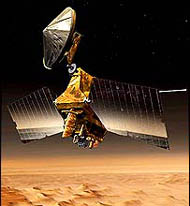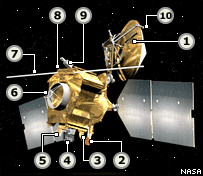Mars Reconnaissance Orbiter
Mars Reconnaissance Orbiter is a NASA space probe, launched on 12 August 2005, that has made high-resolution measurements of the surface of Mars from orbit, including images with resolution better than one meter. The primary objectives of the mission will be to look for evidence of past or present water and to identify landing sites for future missions. The orbiter will also be used as a telecommunications link for future missions.
 |
Mars Reconnaissance Orbiter (MRO) is the biggest spacecraft to be sent to Mars, carrying some of the most sophisticated instruments ever. The spacecraft went into an elliptical parking orbit around the Red Planet on 11 March 2006. It will study the planet's composition and structure and serve as a powerful communications relay for future missions to the surface.
 |
| 1. 3m High-gain antenna; 2. High-resolution Imaging
Science Experiment; 3. Electra UHF communications relay; 4. Mars Climate
Sounder; 5. Compact Reconnaissance Imaging Spectrometer for Mars;
6. Orbit insertion thrusters; 7. Shallow subsurface radar; 8. Thrusters;
9. Optical Navigation camera; 10. Low-gain antennae
|
One of its scientific objectives is to explore whether Mars could once have supported microbial life. Its cameras and spectrometers will search the surface for features related to water, without which life is not thought able to survive. Meanwhile, a radar sounder will look for liquid water reservoirs that may exist beneath the surface of Mars.
MRO joined two US orbiters – Mars Global Surveyor (now defunct) and Mars Odyssey – and one European orbiter, Mars Express, at the fourth planet.


